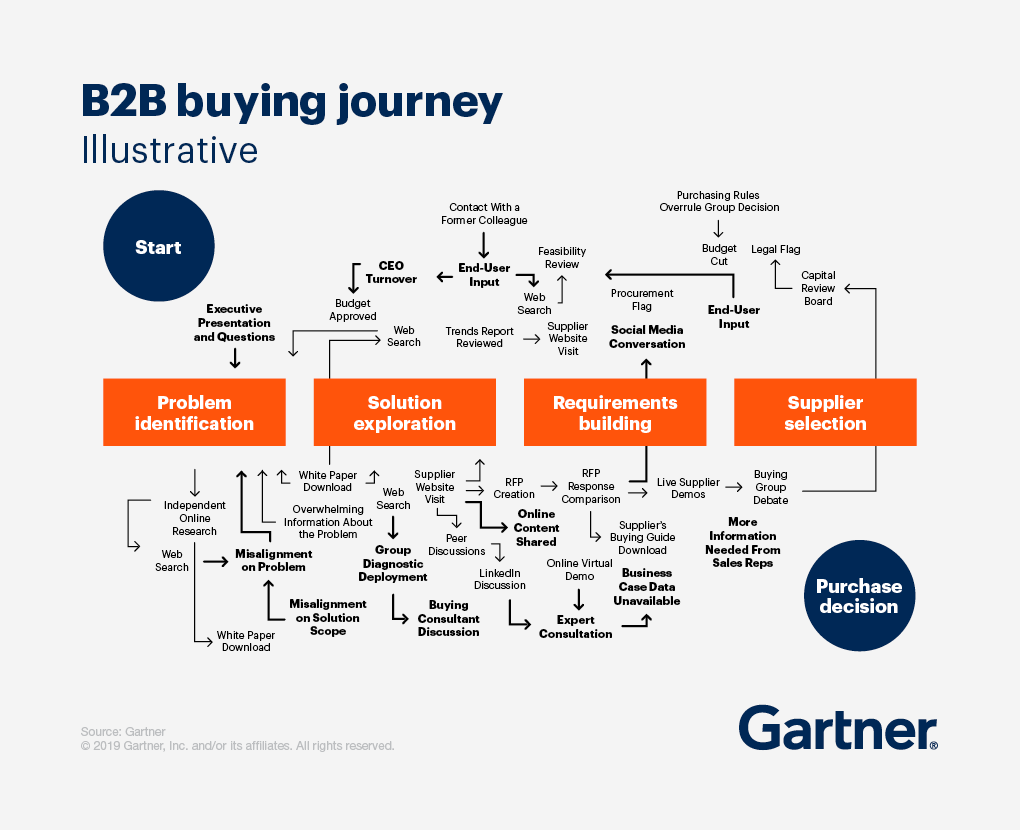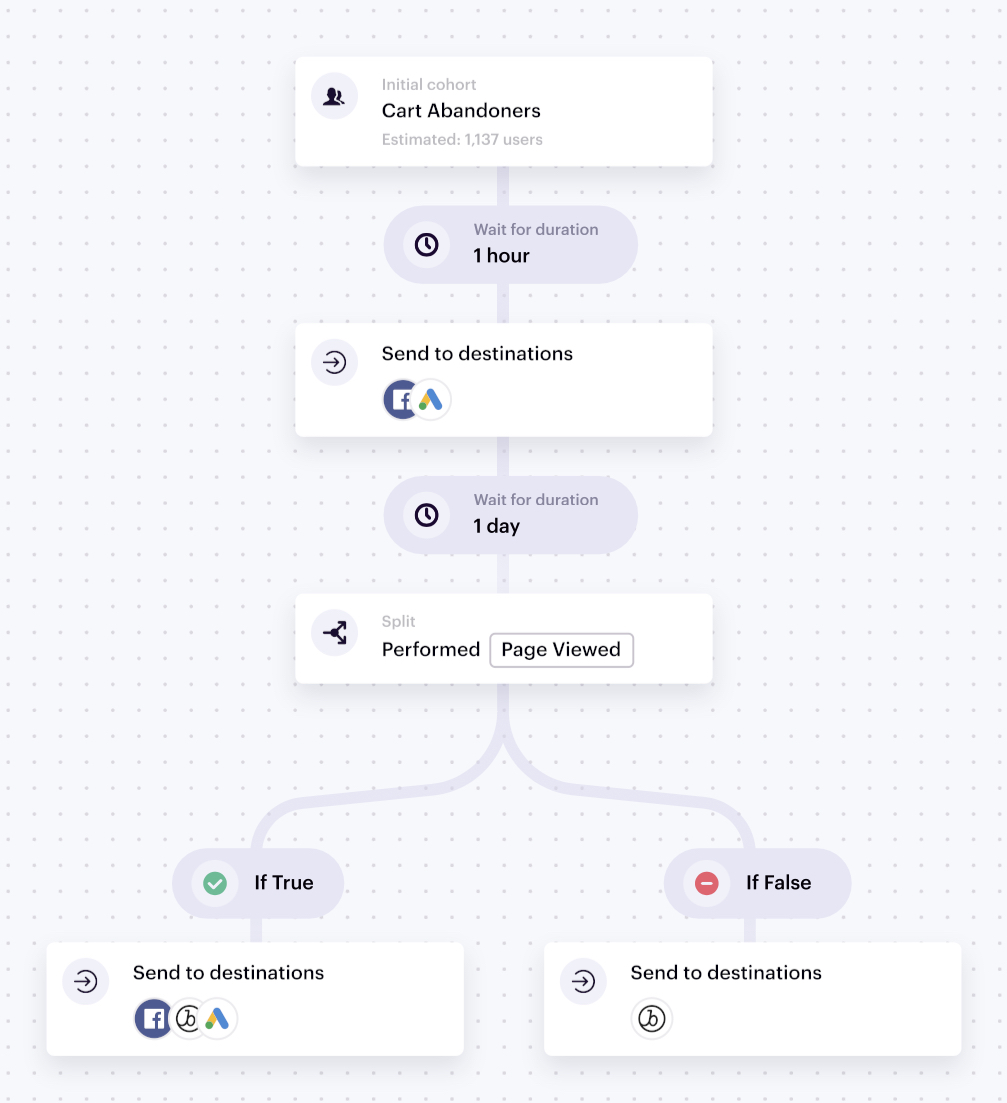How to Build an Effective B2B Marketing Strategy
We overview the steps involved with creating a B2B marketing strategy that works.
We overview the steps involved with creating a B2B marketing strategy that works.
B2B (or business-to-business) marketing can be complex to navigate. There are more stakeholders than in a B2C exchange between a business and customer, and the buyer’s journey tends to be longer.
But with quality customer data and the right tools in your tech stack, you can craft a B2B marketing strategy that effectively captures your target market. Here’s how.
Like any good marketing strategy, you need to know your audience and tailor your message accordingly. Perhaps you market to a few different personas, or want to tailor messages based on where buyer’s are in the funnel (a wise, and often necessary move).
Here are a few categories for segmenting your customers:
Firmographics – The B2B equivalent of customer demographics, firmographics encompasses data such as a company’s location, annual revenue, and the number of employees. Use this model to create mutually exclusive segments, such as SMB vs. enterprise.
Technographics – This model segments customers based on the software and hardware they use. Choose this model if you offer a range of products that target different companies based on the technology they have.
Tiering – Use this model to identify the most suitable customers for your business based on specific criteria, such as a minimum annual spend for products, the startup growth stage, or technological maturity.
Needs-based – Group customers based on their most important needs, be it affordability, quality, service, or partnership.
💡Learn more in our Guide to B2B Customer Segmentation Methods.
In B2B marketing, you interact with several stakeholders. They include the end user, influencer, economic buyers, and decision makers. Larger businesses involve more gatekeepers, especially if their product requires a large upfront investment and introduces a significant change to their processes.
To identify the stakeholders in your target business, ask a lead within the company and conduct your own research on LinkedIn or the company website. You can also find information from B2B databases – but keep in mind that those are third-party customer data and may not be reliable. To ensure accuracy and protect your customers’ privacy, opt for first-party data, or the data you gather on customers’ direct interactions with your business (with their consent).
A buyer persona is a representation of your ideal customer that depicts their problems, goals, habits, roles within the company, and so forth. To flesh out each persona, you can conduct interviews or send surveys to potential and existing customers. Along with that, you can supplement this information with first-party data to gain insight into what channels a customer prefers, what ads or content they engage with, or what parts of your app/product they’re most interested in.
Each stakeholder has different goals and problems, which means they require a different persona profile.
For instance, if you sell employee wellness programs, you’ll need to address the following pain points (in theory):
Employees want programs that are enjoyable and helpful without consuming too much of their time.
Team leaders want programs that will help their members be more productive.
HR managers want the ability to measure the program’s effectiveness in boosting employee engagement and retention.
Financial executives want an affordable program that doesn’t take too long to generate ROI.
💡Semrush has some excellent tips and examples on creating B2B buyer personas – check them out here.
With any campaign, you want to establish metrics and benchmarks that will serve as your indicators of success.
Say the goal is for your SaaS product to gain network effects (or when the value of the product/app relates to how many people use it). One relevant KPI would be the growth of social referrals each quarter. To track that, you could monitor the engagement of each social post to see if your audience is interested in the content and sharing it with their network.
The B2B buying journey is non-linear. Different stakeholders discover your brand at different times, and through different channels. By finding out how this discovery process takes place, you can design marketing campaigns that correlate to each stage of the buyer’s journey.

Gartner illustrates how complex the B2B buying experience can be.
Use analytics and attribution tools like Google Analytics, Tapstream, and Attribution to find out which traffic sources led people to your website or app, and what pages they visited first. Link your attribution tool to your customer database – like a customer data platform (CDP) – to identify common discovery journeys within different segments (information that can be added to your buyer personas).
Over time, you can refine your B2B marketing strategy by replicating the campaigns that successfully led to brand discovery. These can be different for each stakeholder – for instance, end users discover your brand through blogs, influencers through podcasts and webinars, and decision makers through case studies shared by their network.
Evaluate marketing channels based on the most important factors for your business. These can include:
The customer journey – Invest in the marketing channels where your target persona is the most engaged.
Current business goals – Different channels are better suited to achieve specific goals, like lead generation and brand awareness. Social media helps you grow your subscriber base quickly through viral marketing, blogs let you educate customers, and community outreach lets you reach niche communities and encourage users to do and share projects using your product.
Budget – Consider not only how much you can spend per quarter but also your target ROI period. Allocate your budget based on projected customer acquisition cost per channel.
Targeting ability – Determine the level of targeting sophistication you require to run effective personalized campaigns. Channels like digital advertising platforms and email let you send different messages to custom audience segments.
Input and output time – Choose a channel with an input and output period you find acceptable, given your marketing manpower, budget, and goals. SEO and communities take time to nurture. Results may take months to yield, but they also tend to compound as the years go by, particularly with SEO. In contrast, paid advertising and viral marketing give you more results in less time. Once your advertising period has expired or the virality has faded away, these channels stop yielding results. Still, the leads and customers you gained might continue spreading the word about your products or brand.
💡Learn more about choosing the right channel for your product.
Omnichannel marketing means giving customers a seamless experience engaging with your business, no matter what channel they use (or how often they switch between them). It means not showing a prospect an ad on Instagram that they’ve marked as irrelevant on Facebook. It means emailing a customer a voucher for items that complement a product they’ve recently purchased – not promoting the same item they’ve just bought.
The omnichannel approach to marketing requires unifying customer data from multiple sources to gain a single customer view. With all data in one place, it’s easier to create marketing workflows using criteria based on actions customers have taken on one channel or ads they’ve viewed on another.
💡Learn more with The Ultimate Guide to Omnichannel.
Each channel – whether it be Twitter, Spotify, or SMS – has its own characteristics, content format, and audience. That’s why it’s crucial to create content that’s designed to resonate within a single channel, not across many.
In practice, this means an ad for Facebook should have distinct copy and design from an ad for LinkedIn – not just different graphic sizes. An article written for a blog shouldn’t simply be shared with an excerpt or summary on social media. You need to take the gist of that article and create a totally new post designed for maximum engagement on a different platform, like creating a tweet thread for Twitter and a carousel story for LinkedIn.
Examine your marketing activities and identify routine, manual tasks in the following processes:
Email marketing
Social media marketing
Advertising
Analytics
Customer segmentation
If you perform those tasks regularly and the steps involved can be automated, then it’s likely worth automating. Choose marketing automation software that fits your needs, assessing them based on their features, integrations, and scalability.
💡For more on how to automate marketing processes, check out this guide.
A centralized customer database and automated workflows are essential for running personalized B2B marketing campaigns at scale. As a CDP, Segment provides both capabilities.
A single customer view means you have one location for all the information you’ve gathered on your customers across multiple channels. Unified data gives you a complete picture of each customer’s journey, lets you perform more granular and accurate customer segmentation, and enables personalized campaigns based on a customer’s most recent activity.
Segment CDP centralizes your customer data from multiple sources to provide this. It uses identity resolution to recognize the same customer across different channels, and then stitches all that data into a single profile.
A CDP like Segment can track customer engagement across different channels. You simply integrate an engagement channel with Segment using an API. SMS, email, call center conversations, social media, and your own website’s chatbot are all examples of channels you can connect to Segment as data sources.
Use your customer engagement metrics as a basis for the types of data you want to collect from those sources through Segment. If you want to track churn, you’d collect data on churn actions, as well as on behaviors that indicate potential churn.
Orchestrate omnichannel experiences by linking your customer engagement and marketing channels as data Destinations in Segment. As you’ll be using data from your CDP, every action you execute on each channel will be based on the latest customer activity or inactivity across all your channels.
For example, you can run a campaign to win back cart abandoners using a combination of Facebook ads, Google ads, and email. If a customer clicks on a Facebook ad that brings them back to their cart, they’d stop seeing that ad across all platforms.

Connect with a Segment expert who can share more about what Segment can do for you.
We'll get back to you shortly. For now, you can create your workspace by clicking below.
A SaaS company promoting its accounting software to other businesses is an example of B2B marketing. Depending on whether they were marketing to an SMB or enterprise, they may change their marketing strategy to promote a different range of add-ons, or a specific pricing tier.
The B2B buying experience can be complex, involving multiple stakeholders, a non-linear product discovery and decision-making process, and a medium-to-long sales cycle. You need to identify the pain points and goals of each stakeholder and craft different marketing campaigns for each one.
The best channels for B2B marketing are the ones that have high customer engagement, and are appropriate for sending work-related messages. To choose a B2B marketing channel, evaluate each option based on your business goals, budget, desired level of targeting ability, and acceptable input and output time.
Twilio Engage lets businesses execute omnichannel B2B marketing campaigns from a single platform. Twilio Engage is built on top of the Segment CDP, enabling marketers to tailor campaigns based on accurate customer segments, rich customer profiles, and real-time customer data.